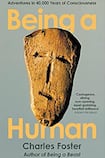
A few years ago, the writer, barrister and traveller Charles Foster tried to become an animal. In Being a Beast, published in 2016, he documented his attempts to live as a badger in the woods.
Being a Human is a continuation of this exploration into the other and, by default, the self. Foster turns the lens on his own species, setting out to become an Upper Palaeolithic hunter-gatherer, a Neolithic farmer and an Enlightenment brain in a bid to understand our contemporary reflexes, our desires, the way we think and feel. This is, he tells us, because these ages still rule us.
From the Upper Palaeolithic we derive our capacity to record and observe events. The Neolithics gave us our lust for compartmentalisation, dominion and control, but also our wish to cosset and nurture Earth. The Enlightenment, a mere coda in the contribution of the phases to the kind of animal we are now, nonetheless taught us scepticism and empiricism – qualities, suggests Foster, that are desperately needed today if we are to recover enchantment, to look fearlessly and without bias at the natural and human worlds.
First up are the Upper Palaeolithics, who lived about 35,000 to 40,000 years ago, and with whom Foster spends the most time, devoting almost 200 pages to his attempt to turn himself into a hunter-gatherer. That’s compared with the 100 pages he offers the Neolithics and the brusque 30 or so he gives to the Enlightenment. This is because humans spent much longer in the Upper Palaeolithic phase than either of the other two, but also, as Foster freely admits, because he likes these people better.
“Hunter-gatherers were wanderers, intimately, reverently and often ecstatically connected to lots of land and many species. They lived long and relatively disease-free lives and there is little evidence of human-human violence.” They also had more leisure time, making the era one of reflection, of story. “The earliest human art, on the cave walls of southern Europe, is among the best there has ever been.”
Foster goes to see this cave art, in a medieval library in Oxford. But, for the most part, this book replicates the approach of Being a Beast, with the author heading into the winter woods in the Peak District accompanied by his 13-year-old son Tom, where they intend to “make a shelter, kill things and stare into fires until Christmas”.
Tom was there also in Being a Beast, acting like a badger along with his dad, and is game for this new adventure. The duo skin foxes and rabbits with homemade flint-stones, light fires of hawthorn sticks and, because there are no longer any caribou in Derbyshire, follow the circuits of magpies and robins.
They are shadowed, most of the time, by two mysterious characters from the era, X and his son, and Foster leaves it up to us to decide if these are real or not. The idea, explains the author, is to be in at the start of human behavioural modernity. “To feel the first rush of Self as subjectivity is injected, to watch the first flickerings of consciousness and the first detonation of story.”
It’s a big ask, as he acknowledges, but by the end of the book’s first section, after four seasons immersed in the feelings, doings and locales of our Upper Palaeolithic ancestors, Foster thinks he might have got somewhere. He has felt himself part of the natural world, slowed down to the pace of the trees, sped up to the pace of a wren’s heart, paid attention to the smell of the cold, noticed the walls thinning between the spaces of the living and the dead.
He has done lots of staring into fires, which is all that is needed, he discovers,
for the kindling of consciousness. The only problem is he has to move on. The Neolithic and the Enlightenment, both a lot less fun, a lot further away from the place where we were born, lie in wait.
Foster is an amiable narrator. He is self-deprecating, feminist, in awe of what the natural world has to teach him. His observations – that it is hard to say where humans stop and aurochs begin; that the great disaster of the Enlightenment was its reduction of the universe to a machine – align firmly with those of Donna Haraway and Amitav Ghosh in recalling us to the epic mysticism of existence.
He is, I think, also an optimist, still hopeful for humanity, even if we are never again going to run around Derbyshire in a deerskin loincloth. It’s laughable, Foster asserts, to consider modern humans as normative; in fact, we are recent and palpably inadequate mutations.
“Take heart,” he writes, “we can reverse the mutation.”













